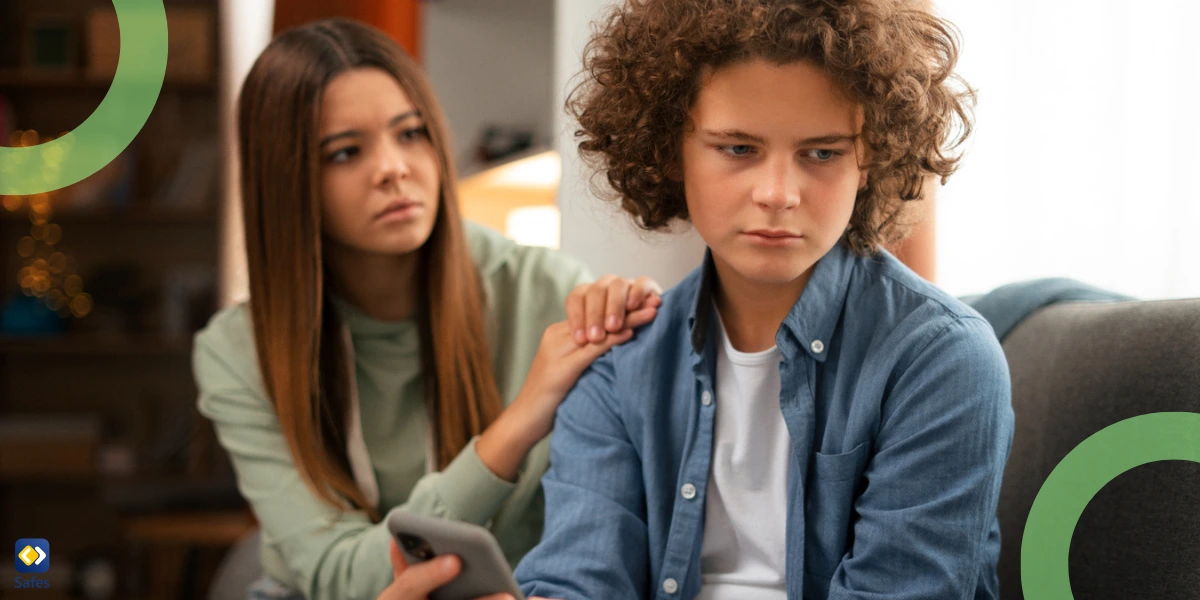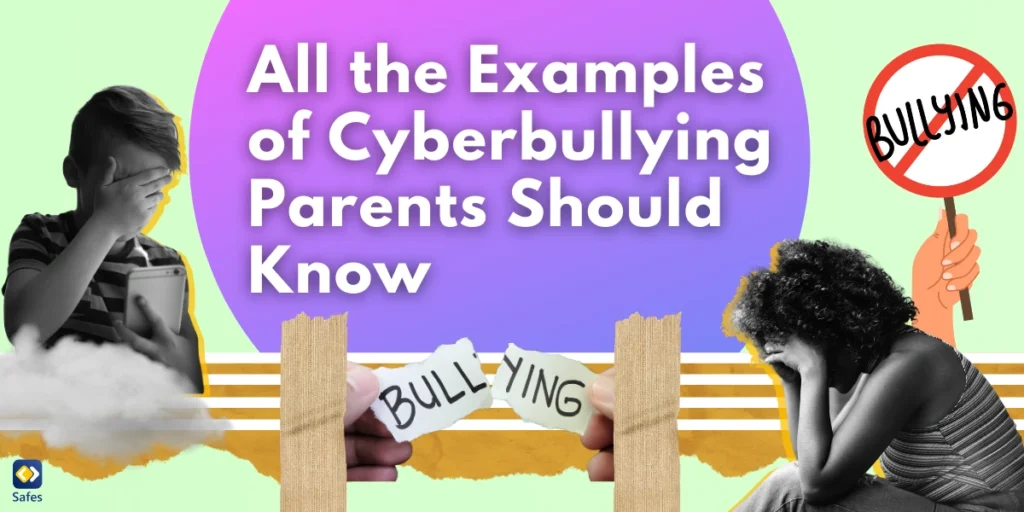The digital age has revolutionized the way young people connect and communicate, but it’s also given rise to a disturbing phenomenon: cyberbullying. For parents, understanding the types and examples of cyberbullying is crucial in identifying and addressing this harmful behavior. In this blog, we will explore what cyberbullying looks like in practice, how it impacts children, and how tools like parental control apps can help protect kids from online abuse.
Download and Start Your Free Trial of the Safes Parental Control App
What Are Examples of Cyberbullying?
Cyberbullying occurs when someone uses technology to harass, threaten, embarrass, or target another individual. This form of bullying behavior can manifest in various ways, each with unique effects on its victims. Below are some common examples of cyberbullying:
- Name-Calling and Insults: Hurtful messages sent via text messages or instant messages, often laced with cruel insults about appearance, race, or sexual orientation.
- Spreading Rumors: Sharing false or private information on social media platforms to embarrass or isolate someone.
These online bullying examples highlight how damaging words and actions can be, even without physical contact. Many victims report the effects of cyberbullying including feeling isolated, anxious, and even afraid to attend school or participate in social activities. The impact of this behavior can last long after the bullying stops.
Some parents might wonder, “What is an example of cyberbullying?” A clear illustration would be when a group of classmates creates a fake profile to impersonate someone, posting offensive content under their name. This type of behavior not only humiliates the victim but can also tarnish their reputation. Cyberbullying occurs in many forms, and identifying it early is vital for intervention.
For a deeper understanding and additional insights into the broader implications, read our article on What is Cyberbullying.
Examples of Cyberbullying Text Messages
Text messages and instant messages are also common tools for cyberbullies. Here’s an example of harassment through cyberbullying in this context:
- Threatening Messages: Sending texts that intimidate or scare the recipient.
- Group Chat Targeting: Ganging up on someone in a group chat, often mocking or ridiculing them.
The persistent nature of text message bullying behavior can make it particularly harmful. Victims of cyberbullying often feel trapped because they can’t easily escape the harassment that follows them wherever their phone goes. For example, a child might receive threatening texts daily, making them fearful of even checking their phone.
Parents should monitor their children’s phones for any examples of cyberbullying text messages and encourage them to share their experiences. Open communication ensures children feel comfortable seeking help when needed.
Examples of Cyberbullying on Social Media
Social media sites have become a breeding ground for cyberbullying due to their popularity among young people. Examples of cyberbullying on Instagram, Snapchat, and other platforms include:
- Public Shaming: Posting embarrassing photos or videos of someone without their consent.
- Exclusion: Deliberately leaving someone out of a group chat or unfollowing them as a form of rejection.
The effects of cyberbullying on social media are far-reaching because harmful posts can quickly go viral, amplifying the humiliation for victims. Social media platforms provide bullies with anonymity, making it easier for them to target others without facing immediate consequences.
For instance, an example of harassment cyberbullying on Instagram might involve a bully posting altered photos of a classmate with hurtful captions. Such posts can spread quickly, drawing negative attention to the victim. Parents should encourage children to talk to a trusted adult if they experience such bullying.
Explore further on How to Stop Cyberbullying.

How Cyberbullying Differs Across Platforms
Different social media platforms enable unique forms of cyberbullying. Here are a few examples of cyberbullying on Instagram and other popular platforms:
- Instagram: Anonymous accounts spreading hateful comments or creating fake profiles to impersonate and mock someone.
- TikTok: Editing videos to ridicule someone’s appearance or behavior and posting them for public ridicule.
- X (formerly Twitter): Coordinated campaigns to flood a victim’s feed with harmful comments or derogatory hashtags.
- Snapchat: Sharing private or embarrassing snaps without permission, often among larger groups.
- Discord: Group servers where users gang up to harass or share harmful content about someone, often in private or semi-private chats.
Understanding these platform-specific bullying behaviors can help parents better monitor their child’s online activity. For instance, on Instagram, victims of cyberbullying may be targeted through group direct messages where bullies gang up to insult or humiliate them.
Other Online Bullying Examples and Their Consequences
Cyberbullying does not only take place on social media platforms but can take many forms, each with its own set of consequences. Some common types of cyberbullying include:
- Trolling: Sending threatening or distressing messages on social networks, chat rooms, or online games to harass or upset others.
- Exclusion: Isolating a child from online games, activities, or friendship groups, leading to social alienation.
- Hate Pages: Creating social media accounts, webpages, or groups specifically designed to target and ridicule a particular individual.
- Encouraging Self-Harm: Urging young people to engage in self-destructive behaviors, often through online messages or content.
- Abusive Polls: Running polls where users vote in a harmful or offensive manner, often to degrade or harm a person.
- Digital Impersonation: Using someone’s identity to post inappropriate content or messages, damaging their reputation and making others believe they are the ones behind the harmful actions.
- Sexting and Explicit Messages: Sending sexually explicit messages, commonly referred to as sexting, which can involve coercion or manipulation.
- Pressuring for Sexual Content: Coercing children into sending sexual images or engaging in explicit conversations online.
- Doxxing: Publishing private or personal information about someone online without their consent, often to intimidate or harass them.
- Malicious Memes: Circulating memes that mock, ridicule, or dehumanize someone based on their appearance, personality, or actions.
The effects of cyberbullying aren’t limited to the digital world. Research shows victims of cyberbullying often suffer from anxiety, depression, low self-esteem, antisocial actions, and even suicidal thoughts and intentions. For instance, an example of a cyberbullying case might involve a teenager who becomes the target of relentless doxxing, leading them to fear for their privacy and safety.
Parents should teach children how to recognize different types of cyberbullying and provide strategies for dealing with them effectively.
Examples of Cyberbullying Stories in Real Life
Real-life examples of cyberbullying cases reveal the devastating impact this type of abuse can have on young people. Let’s look at two notable examples of cyberbullying in real life
Ira from Belarus
12-year-old Ira from Belarus loved bloggers and decided to start her own social media blog. She began recording stories in the morning, making short videos with her friends during breaks, and sharing what she did after school. However, things took a turn when a stranger with a carnival mask avatar started making unsettling comments about her personal life. Feeling unsafe and anxious, Ira reached out for help after seeing a helpline poster at school. A psychologist advised her to take control by blocking the person and limiting her social media to close friends. With the support of her mother, Ira made changes to feel safer online, and her story highlights the importance of awareness and support in preventing online bullying.
Megan Meier
Megan Meier, a 13-year-old girl, struggled with self-esteem and depression. She befriended a boy named “Josh Evans” on MySpace, only to discover he was a fake profile created by the parents of a former friend. After a series of cruel messages, Megan tragically took her life. Her parents later learned the account was created to manipulate and mock Megan. This heartbreaking case led to calls for stronger cyberbullying laws. More details can be found on the Megan Meier Foundation’s.
Stories like these underline the importance of parents staying vigilant and encouraging open communication about their child’s online experiences. Victims of cyberbullying often withdraw from friends and family, making it crucial for parents to intervene early.
The Role of Trusted Adults in Combating Cyberbullying
One of the most effective ways to combat cyberbullying is through open communication between children and trusted adults. Here’s how parents can help:
- Encourage Transparency: Make sure your child feels comfortable discussing their online interactions with you.
- Set Boundaries: Establish clear rules about the use of social media platforms and group chats.
By staying involved, parents can help their children navigate the challenges of the digital world while fostering a safe environment. Building trust ensures that children will reach out when they feel threatened or uncomfortable online.

How Safes Can Help Prevent Cyberbullying
Safes, a parental control app available on Android and iOS, offers a comprehensive solution to protect children from the harmful effects of cyberbullying. Here’s how it works:
- Monitor Social Media Activity: Safes allows parents to keep an eye on their child’s interactions on social media sites.
- Filter Harmful Content: The app automatically blocks inappropriate or harmful content, reducing exposure to online abuse.
- Track Text Messages: Parents can use Safes to monitor examples of cyberbullying text messages, ensuring their child is not being harassed.
For parents using different devices, there are various parental control options:
- Windows parental controls can help monitor and restrict access to harmful websites on a child’s PC.
- Macbook parental controls allow parents to set limits on their child’s MacBook usage, including content restrictions.
- Parental controls on Android ensure that your child’s Android device is safe from cyberbullying by monitoring apps and content.
- iPhone parental controls can block inappropriate content and manage screen time, keeping your child’s online activities secure.
With tools like Safes, parents can ensure their child’s online experience is safer and more positive. Interested in trying Safes? Start your free trial today and take the first step in combating cyberbullying.
Conclusion: Staying Informed and Taking Action
Understanding the many examples of cyberbullying for kids is a critical first step in protecting them. From spreading rumors on social media to receiving threatening text messages, cyberbullying can take many forms. By staying informed, fostering open communication, and using tools like Safes, parents can create a safer online environment for their children.
Your Child’s Online Safety Starts Here
Every parent today needs a solution to manage screen time and keep their child safe online.
Without the right tools, digital risks and excessive screen time can impact children's well-being. Safes helps parents set healthy boundaries, monitor activity, and protect kids from online dangers—all with an easy-to-use app.
Take control of your child’s digital world. Learn more about Safes or download the app to start your free trial today!




